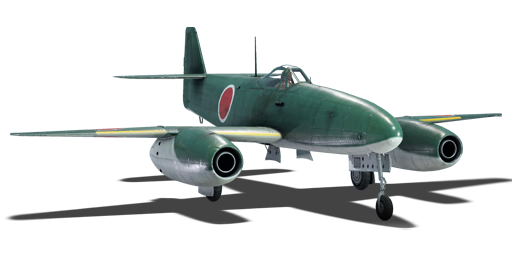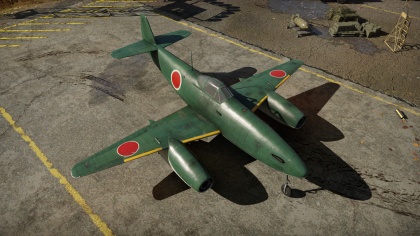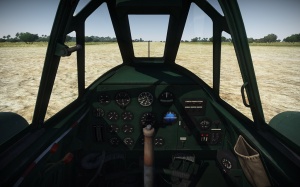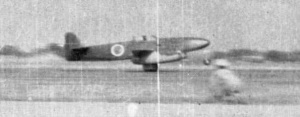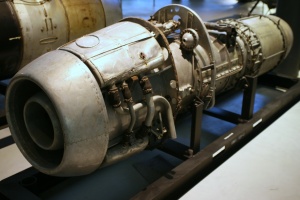Difference between revisions of "Kikka"
(Updated page template) |
PropterHoc (talk | contribs) m (Grammar and some tactical information) (Tag: Visual edit) |
||
| Line 109: | Line 109: | ||
! colspan="3" | Aircraft mass | ! colspan="3" | Aircraft mass | ||
|- | |- | ||
| − | ! rowspan="2" | Number || rowspan="2" | Booster<br/>weight (each) ||rowspan="2" | Fuel<br/>weight (each) ||rowspan="2" | Burn<br/>Time ||rowspan="2" | Can be<br/>shutdown||rowspan="2" | Jettisoned<br/>after use | + | ! rowspan="2" | Number || rowspan="2" | Booster<br />weight (each) || rowspan="2" | Fuel<br />weight (each) || rowspan="2" | Burn<br />Time || rowspan="2" | Can be<br />shutdown|| rowspan="2" | Jettisoned<br />after use |
! colspan="3" | Mass with full booster fuel (no weapons load) | ! colspan="3" | Mass with full booster fuel (no weapons load) | ||
|- | |- | ||
| Line 119: | Line 119: | ||
! colspan="2" rowspan="2" | Condition | ! colspan="2" rowspan="2" | Condition | ||
! colspan="2" rowspan="2" | {{Annotation|Maximum booster<br/>thrust @ 0 m (RB / SB)|The maximum thrust produced by each booster, while mounted in the aircraft. NOTE: Thrust varies significantly depending on speed & altitude.}} | ! colspan="2" rowspan="2" | {{Annotation|Maximum booster<br/>thrust @ 0 m (RB / SB)|The maximum thrust produced by each booster, while mounted in the aircraft. NOTE: Thrust varies significantly depending on speed & altitude.}} | ||
| − | ! colspan="2" rowspan="2"| {{Annotation|Combined engine<br/>& booster thrust @ 0 m|The total thrust produced by all engines and boosters. NOTE: Thrust varies significantly depending on speed & altitude.}} | + | ! colspan="2" rowspan="2" | {{Annotation|Combined engine<br/>& booster thrust @ 0 m|The total thrust produced by all engines and boosters. NOTE: Thrust varies significantly depending on speed & altitude.}} |
! colspan="3" | Thrust to weight ratio @ 0 m (100% with booster) | ! colspan="3" | Thrust to weight ratio @ 0 m (100% with booster) | ||
|- | |- | ||
| Line 163: | Line 163: | ||
== Usage in battles == | == Usage in battles == | ||
<!-- ''Describe the tactics of playing in the aircraft, the features of using aircraft in a team and advice on tactics. Refrain from creating a "guide" - do not impose a single point of view, but instead, give the reader food for thought. Examine the most dangerous enemies and give recommendations on fighting them. If necessary, note the specifics of the game in different modes (AB, RB, SB).'' --> | <!-- ''Describe the tactics of playing in the aircraft, the features of using aircraft in a team and advice on tactics. Refrain from creating a "guide" - do not impose a single point of view, but instead, give the reader food for thought. Examine the most dangerous enemies and give recommendations on fighting them. If necessary, note the specifics of the game in different modes (AB, RB, SB).'' --> | ||
| − | The Kikka has | + | The Kikka has a decent acceleration rate for it's BR, as well as climb rate, and low top speed for a jet. The pilot is quite heavily protected from the front and rear by both armour, and the fuel tanks are self sealing. The (wing mounted) engines, on the other hand, take damage easily, and minor damage to them will further slow the plane to speeds that some props can match. |
| − | The guns are very powerful and can down fighters in a few solid shots, but they | + | The guns are very powerful and can down fighters in a few solid shots, but they sometimes spark upon impact and do no damage. |
[[File:CockpitImage_Kikka.jpg|thumbnail|right|Inside the cockpit of the Kikka]] | [[File:CockpitImage_Kikka.jpg|thumbnail|right|Inside the cockpit of the Kikka]] | ||
The Kikka should be played as a Boom & Zoomer. It has a good roll rate so it can still catch enemies that attempt to dodge your attack. Pursuers can be outrun by going into a slight dive. | The Kikka should be played as a Boom & Zoomer. It has a good roll rate so it can still catch enemies that attempt to dodge your attack. Pursuers can be outrun by going into a slight dive. | ||
| − | Most jets are a significant threat to the Kikka. As noted earlier, it has weak engines so aside from the [[Yak-15]] and [[Yak-17]] | + | Most jets are a significant threat to the Kikka. As noted earlier, it has weak engines, so aside from the [[Yak-15]] and [[Yak-17]] most other jets will be able to catch up to it. |
| − | Super props like the P-51H-5NA can also catch the Kikka. | + | Super props like the P-51H-5NA can also catch the Kikka in certain situations, though the Kikka's top maintainable speed is much higher than theirs. |
| − | To attempt to gain the upper hand on a Kikka, propeller planes should dive from at least 2,000 m above the Kikka to be able to catch | + | To attempt to gain the upper hand on a Kikka, propeller planes should dive from at least 2,000 m above the Kikka to be able to catch it. If the Kikka goes into a tight turn fight, it will generally bleed its energy, making it an easy target to be defeated by prop planes, like many jets. |
=== Modules === | === Modules === | ||
| Line 254: | Line 254: | ||
== See also == | == See also == | ||
''Links to the articles on the War Thunder Wiki that you think will be useful for the reader, for example:'' | ''Links to the articles on the War Thunder Wiki that you think will be useful for the reader, for example:'' | ||
| + | |||
* ''reference to the series of the aircraft;'' | * ''reference to the series of the aircraft;'' | ||
* ''links to approximate analogues of other nations and research trees.'' | * ''links to approximate analogues of other nations and research trees.'' | ||
| Line 259: | Line 260: | ||
== External links == | == External links == | ||
''Paste links to sources and external resources, such as:'' | ''Paste links to sources and external resources, such as:'' | ||
| + | |||
* ''topic on the official game forum;'' | * ''topic on the official game forum;'' | ||
* ''encyclopedia page on the aircraft;'' | * ''encyclopedia page on the aircraft;'' | ||
Revision as of 03:10, 26 June 2020
Contents
Description
The Kikka is a rank V Japanese jet fighter
with a battle rating of 7.0 (AB/RB) and 6.7 (SB). It was introduced in Update 1.43.
The Kikka is a well-armed and powerful fighter-bomber. The Kikka starts out with a single 30 mm and you will have to research the 'otsu' mod before you can obtain the second 30 mm. It is important you utilize your speed to your advantage, as that is its biggest advantage against most aircraft it encounters. A good turner in high speeds, but in low speeds you may find it difficult to turn as well as to regain your speed. Always maintain an energy advantage over your enemies, so you can quickly engage and disengage your targets. Never try to keep on them unless you know you have the advantage. It is recommended you do not 'head-on' other targets until you have acquired the Otsu mod. The Kikka is a very durable and well armoured aircraft, so it can take a multiple hits in a head-on.
Regarding its bombing capabilities, it makes the Kikka significantly slower and can be difficult to control. Speed is a must with the Kikka, and it is recommended you perform high-speed dive bombing to ensure the destruction of your target and to escape pursuers. The speed you gained in your dive can be maintained by your now unburdened plane. Make sure to use the rocket boosters to take off or else the aircraft will have significant difficulty taking off with bombs equipped and be unable to retract the landing gear.
General info
Flight performance
Describe how the aircraft behaves in the air. Speed, manoeuvrability, acceleration and allowable loads - these are the most important characteristics of the vehicle.
| Characteristics | Max Speed (km/h at 3,000 m) |
Max altitude (metres) |
Turn time (seconds) |
Rate of climb (metres/second) |
Take-off run (metres) | |||
|---|---|---|---|---|---|---|---|---|
| AB | RB | AB | RB | AB | RB | |||
| Stock | 786 | 773 | 12500 | 26.2 | 27.4 | 20.7 | 19.5 | 750 |
| Upgraded | ___ | ___ | __._ | __._ | __._ | __._ | ||
Details
| Features | |||||
|---|---|---|---|---|---|
| Combat flaps | Take-off flaps | Landing flaps | Air brakes | Arrestor gear | Drogue chute |
| ✓ | ✓ | ✓ | X | X | X |
| Limits | ||||||
|---|---|---|---|---|---|---|
| Wings (km/h) | Gear (km/h) | Flaps (km/h) | Max Static G | |||
| Combat | Take-off | Landing | + | - | ||
| 980 | 380 | 580 | 580 | 380 | ~11 | ~5 |
| Optimal velocities (km/h) | |||
|---|---|---|---|
| Ailerons | Rudder | Elevators | Radiator |
| < 590 | < 590 | < 650 | N/A |
Engine performance
| Engine | Aircraft mass | |||||
|---|---|---|---|---|---|---|
| Engine name | Number | Empty mass | Wing loading (full fuel, no boosters) | |||
| Nakajima Ne-20 | 2 | 2,440 kg | 228 kg/m2 | |||
| Engine characteristics | Mass with fuel (no weapons load, no boosters) | Max Takeoff Weight | ||||
| Weight (each) | Type | 7m fuel | 20m fuel | 23m fuel | ||
| 470 kg | Axial-flow turbojet | 2,654 kg | 2,951 kg | 3,020 kg | 5,000 kg | |
| Maximum engine thrust @ 0 m (RB / SB) | Thrust to weight ratio @ 0 m (106%, no booster) | |||||
| Condition | 100% | 106% | 7m fuel | 20m fuel | 23m fuel | MTOW |
| Stationary | 572 kgf | 650 kgf | 0.49 | 0.44 | 0.43 | 0.26 |
| Optimal | 572 kgf (0 km/h) |
650 kgf (0 km/h) |
0.49 | 0.44 | 0.43 | 0.26 |
| Booster (Solid-fuel rocket) | Aircraft mass | |||||||
|---|---|---|---|---|---|---|---|---|
| Number | Booster weight (each) |
Fuel weight (each) |
Burn Time |
Can be shutdown |
Jettisoned after use |
Mass with full booster fuel (no weapons load) | ||
| 7m fuel | 20m fuel | 23m fuel | ||||||
| 2 | 50 kg | 350 kg | 6s | No | Yes | 3,454 kg | 3,751 kg | 3,820 kg |
| Condition | Maximum booster thrust @ 0 m (RB / SB) |
Combined engine & booster thrust @ 0 m |
Thrust to weight ratio @ 0 m (100% with booster) | |||||
| 7m fuel | 20m fuel | 23m fuel | ||||||
| Stationary | 816 kgf | 2,932 kgf | 0.85 | 0.78 | 0.77 | |||
| Optimal | 816 kgf (any speed) |
2,932 kgf (0kph) |
0.85 | 0.78 | 0.77 | |||
Survivability and armour
- 70 mm Bulletproof glass - Armoured windscreen
- 12.7 mm Steel plates in front of front fuel tank
- 12.7 mm Steel plate behind the pilot
- 12.7 mm Steel plate behind the rear fuel tank
Armaments
Offensive armament
The Kikka is armed with:
- A choice between two presets:
- 1 x 30 mm Type 5 cannon, nose-mounted (50 rpg)
- 2 x 30 mm Type 5 cannon, nose-mounted (50 rpg = 100 total)
Suspended armament
The Kikka can be outfitted with the following ordnance:
- Without load
- 1 x 500 kg Navy Type Number 50 Model 2 bomb (500 kg total)
- 1 x 800 kg Navy Type Number 80 Model 1 bomb (800 kg total)
Usage in battles
The Kikka has a decent acceleration rate for it's BR, as well as climb rate, and low top speed for a jet. The pilot is quite heavily protected from the front and rear by both armour, and the fuel tanks are self sealing. The (wing mounted) engines, on the other hand, take damage easily, and minor damage to them will further slow the plane to speeds that some props can match.
The guns are very powerful and can down fighters in a few solid shots, but they sometimes spark upon impact and do no damage.
The Kikka should be played as a Boom & Zoomer. It has a good roll rate so it can still catch enemies that attempt to dodge your attack. Pursuers can be outrun by going into a slight dive.
Most jets are a significant threat to the Kikka. As noted earlier, it has weak engines, so aside from the Yak-15 and Yak-17 most other jets will be able to catch up to it.
Super props like the P-51H-5NA can also catch the Kikka in certain situations, though the Kikka's top maintainable speed is much higher than theirs.
To attempt to gain the upper hand on a Kikka, propeller planes should dive from at least 2,000 m above the Kikka to be able to catch it. If the Kikka goes into a tight turn fight, it will generally bleed its energy, making it an easy target to be defeated by prop planes, like many jets.
Modules
| Tier | Flight performance | Survivability | Weaponry | ||
|---|---|---|---|---|---|
| I | Fuselage repair | 14 in (mod. 41) | |||
| II | Engine | Airframe | Offensive 30 mm | ||
| III | Wings repair | Otsu mod. | |||
| IV | Cover | New 30 mm cannons | |||
- Otsu mod. allows the installation of a second 30 mm cannon
Pros and cons
Pros:
- Early jet fighter that can frequently see prop aircraft
- Can carry a large 800 kg Naval bomb
- Can use flaps at high speeds (roughly 550 km/h = 341 mph)
- Good at diving as long as it has enough performance modules
- 30 mm cannons are hard hitters
- Good climb rate and vertical performance
- Great energy retention
Cons:
- Limited ammo, only 50 shells per gun
- Poor turn rate
- Only one 30 mm gun when stock
- Adding payload will hinder handling significantly
- Slow for a jet
- Prop planes will out turn you
- Poor cockpit visibility with an extremely crude aiming sight
History
The Nakajima Kikka or Kitsuka as it is also known, was Japan's first entirely jet-powered aircraft, based loosely on the information they had received on the German Me 262 Schwalbe. Whilst the clear resemblance can be seen, the Japanese were not able to receive all of the information that was provided through a negotiation on 1944 with the German high command over the licencing for plans on both the Me 262, BMW 003 and Junkers Jumo 004 Turbojet engines. Examples and plans were lost with the sinking on a I-29 Submarine that carried the important cargo, however all was not completely lost. Parts of the designs were saved as they were flown in to Japan separate from the Submarine. Upon further inspection of the BMW 003A plans, the Japanese designers found it somewhat similar to their own Ne 12, with the major differences being the German engine used a axial-flow compressor rather than a centrifugal compressor.
Work began on newer engine designs. but ultimately the Ishikawajima Ne 20 engine was the one selected which was an indigenous Japanese design based on the knowledge of the German engines. The Kikka would be noticeably smaller than the German design, with more straight wings as opposed to the swept back leading edge of the Schwalble. Rather than the 4 x 30 mms cannons on the 262, the Kikka would use just one or two Type 5 30 mm cannons. The ever increasing pressure from the B-29 raids ensured that aircraft such as the Kikka were a high priority for the Japanese as interceptor aircraft. However the aircraft would not fly until August 7th 1945, by which time, the Japanese were rapidly running out of time. It would fly again on the 11th August 1945, suffering a crash landing which damaged the aircraft and its engines severely. That would be the last time the aircraft would fly again as just days later, the surrender of Japan was broadcast over the radio, signaling the end of the Kikka development.
Media
See also
Links to the articles on the War Thunder Wiki that you think will be useful for the reader, for example:
- reference to the series of the aircraft;
- links to approximate analogues of other nations and research trees.
External links
Paste links to sources and external resources, such as:
- topic on the official game forum;
- encyclopedia page on the aircraft;
- other literature.
| Nakajima Aircraft Company (中島飛行機株式会社 ) | |
|---|---|
| Fighters | Ki-27 otsu · Ki-27 otsu Tachiarai |
| Ki-43-I · Ki-43-II · Ki-43-III otsu | |
| Ki-44-I · Ki-44-I 34 · Ki-44-II otsu · Ki-44-II hei | |
| Ki-84 ko · Ki-84 otsu · Ki-84 hei | |
| Ki-87 | |
| Hydroplanes | A6M2-N* |
| Interceptors | J1N1 · J5N1 |
| Bombers | B5N2 |
| B6N1 Model 11 · B6N2 Model 12 · B6N2a Model 12Ko | |
| G5N1 · G8N1 | |
| Ki-49-I · Ki-49-IIa · Ki-49-IIb · Ki-49-IIb/L | |
| Recon | E8N2 |
| Jet Fighters | Kikka |
| Captured | ␗Ki-27 otsu · ▃Ki-43-II · ␗Ki-43-III ko · ␗Ki-44-II hei · ␗Ki-84 ko |
| *Refit of the Mitsubishi A6M2 mod. 11 | |
| See also | Fuji Heavy Industries (1957-2017) |
| Japan jet aircraft | |
|---|---|
| IJNAS | |
| Experimental | Kikka |
| Reconnaissance | R2Y2 Kai V1 · R2Y2 Kai V2 · R2Y2 Kai V3 |
| IJAAS | |
| Fighters | Ki-200 |
| JASDF | |
| Fighters | F-86F-30 ▅ · F-86F-40 ▅ · F-86F-40 JASDF▅ |
| F-104J | |
| F-4EJ Phantom II · F-4EJ ADTW · F-4EJ Kai Phantom II | |
| F-15J · F-15J(M) | |
| F-16AJ | |
| F-1 | |
| Trainers | T-2 Early · T-2 |
| Foreign | |
| Thailand | ▄AV-8S · ▄F-5E FCU |


